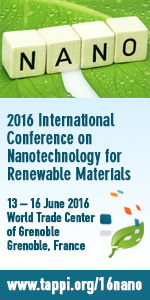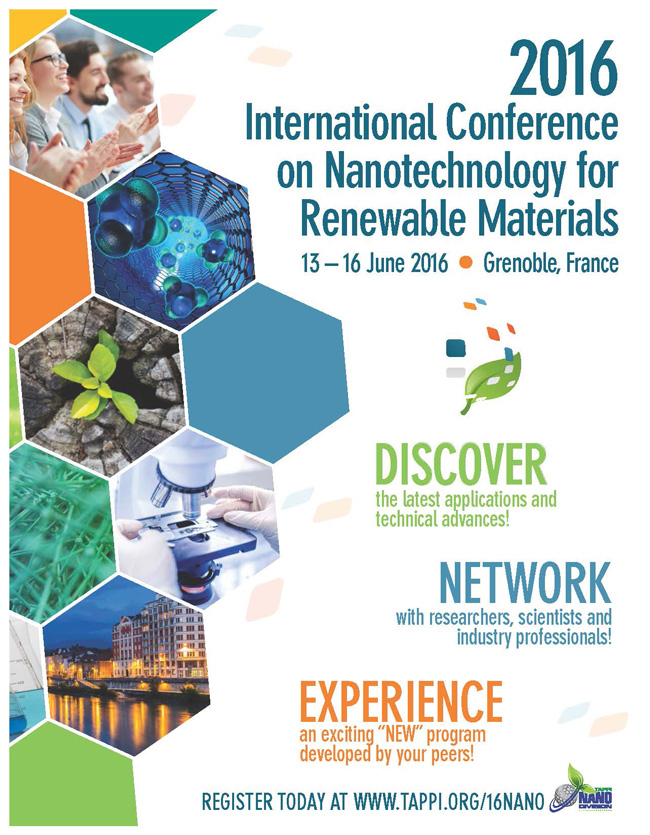 |
||||||||
| May 25, 2016 | ||||||||
| WebAcademy - reduce the knowledge gap at your mill |  |
|||||||
|
· Subscribe to Ahead of the Curve · Newsletters · Ahead of the Curve archived issues · Contact the Editor
|
An Interview with Nano Conference Keynote Maria Doa By Jack Miller, Market-Intell LLC Maria J. Doa, Ph.D is the director of the US Environmental Protection Agency’s Chemical Control Division in the Office of Chemical Safety and Pollution Prevention. She leads activities for the assessment and management of a wide range of industrial chemicals and nanoscale materials under the Toxic Substances Control Act. She is the US lead for the Organization for Economic Cooperation and Development Working Party on Manufactured Nanomaterials. Previously, she led EPA programs to reduce risk to lead, PCBs, mercury and asbestos. She also led EPA’s Toxics Release Inventory Program – a key community right-to-know program about toxic chemicals. Doa will be the keynote speaker at TAPPI’s 2016 International Conference on Nanotechnology for Renewable Materials, which will be held June 13-16 in Grenoble, France. This interview was conducted for TAPPI by Jack Miller, founder and principal consultant, Market-Intell LLC. TAPPI: Maria, you’re giving a keynote at the upcoming International Conference on Nanotechnology for Renewable Materials. Can you tell us a little about your talk? Doa: I was asked to talk about how we review and regulate new chemical substances, including new materials at the nanoscale, at the US Environmental Protection Agency, or EPA. Our mandate is to ensure that these new chemical substances are manufactured and used in a manner that protects against unreasonable risks to human health and the environment. TAPPI: How does this work? What is the process manufacters of nanomaterials need to follow? Doa: The EPA is pursuing a comprehensive regulatory approach under the Toxic Substances Control Act (TSCA). Manufacturers must notify the EPA 90 days before any new chemicals not listed in the TSCA inventory can enter the marketplace. The same applies to modifications to chemicals that are manufactured at the nano scale. EPA will review the notification within the 90 days and identify any concerns. If there are no concerns, the manufacturer can proceed. If there are concerns, EPA can restrict commercial use. For example, we may require safety equipment for workers, or may limit the type of use. TAPPI: Do the manufacturers need to do toxicity testing? Doa: This is not required under the law. However, whatever information you have on the material should be submitted. We do strongly recommend a pre-notification meeting. This way we can identify potential issues up front. Testing that a company may wish to take may mitigate the identified issues. TAPPI: Let’s take nanocellulose as an example. Cellulose is certainly safe. What makes it different if it’s nano? Doa: If it is the nano form of cellulose then a new chemical notification is not required. However, if the cellulose is chemically modified it would likely warrant submission, including nano forms of the modified cellulose. Data indicate that chemicals at the nanoscale may have different properties from materials at the macro scale. For example, some chemicals that are soluble at the macro scale may be poorly soluble at the nano scale and may be respirable, thus they may persist in the lung. Because of the potential for different health and safety impacts, EPA has proposed a one-time reporting for certain chemical substances manufactured at the nanoscale that are already in commerce. EPA would like to get a better picture of these existing chemical substances that are manufactured at the nanoscale. What’s really important here is characterization. Factors include chemical identity, size, morphology, specific surface area, dispersion stability, surface charge and/or surface reactivity. If there is good characterization, it helps to provide a more accurate picture, and this can make it possible to design safer nano materials. TAPPI: It is sometimes said that there are two kinds of lawyers: those that tell you what you can’t do, and those who tell you how to accomplish what you need to accomplish without getting into trouble. So, is EPA, like the first kind of lawyer, or the second? Doa: I’m not sure the analogy fits, but I will say this: the EPA has probably done more regulatory review than anyone. We won’t design a solution, but we do have expertise in how to focus and where to focus. We can help you do what you’re trying to do but minimize risk and keep it safe. Again, though, the key is how well you characterize what you are making. TAPPI: Can you explain a little more why characterization is so important? Doa: Yes. Lack of precision can be an issue. This can include specifications with a wide range, or inconsistency from batch to batch. These things add uncertainty, which adds uncertainty to our risk estimates. With more uncertainty in the risk, we need to be more conservative. Good characterization is also important in health and safety studies so that we can determine the parameters of the material being tested and whether the studies can be used to inform assessments of analogous nanoscale materials. Actually, we are working with the OECD to develop a decision tree for physical and chemical characterization and evaluation of nanomaterials. EPA is also developing scientific methods to study and evaluate unique properties of these substances and how nanoscale materials behave during manufacturing, product use, and end-of-life disposal. TAPPI: Do you have one or two key takeaways for nanocellulose producers? Doa: First, good characterization is the key to making better decisions about nanoscale materials, which can also serve to inform the development of safer nanomaterials. Also, be sure to have a pre-notification meeting before you file notification of new or modified materials—look at the EPA as a resource that can help you make safer materials. The 2016 International Conference on Nanotechnology for Renewable Materials is sponsored by TAPPI’s International Nanotechnology Division. Learn more about the Division at tappinano.org. The 2016 International Conference on Nanotechnology for Renewable Materials is sponsored by TAPPI’s International Nanotechnology Division. Learn more about the Division at tappinano.org. This interview was conducted for TAPPI by Jack Miller, founder and principal consultant, Market-Intell LLC. Jack is the author of Nanocellulose: Technology Applications and Markets, published by RISI in 2014. He has presented on nanocellulose in North America and Brazil, and will be presenting at TAPPI’s 2016 International Conference on Nanotechnology for Renewable Nanomaterials. Now that you are Ahead of the Curve, stay there by joining TAPPI.
For a modest investment of $174, receive more than US$ 1000 in benefits in return. |
|||||||
 |
||||||||


